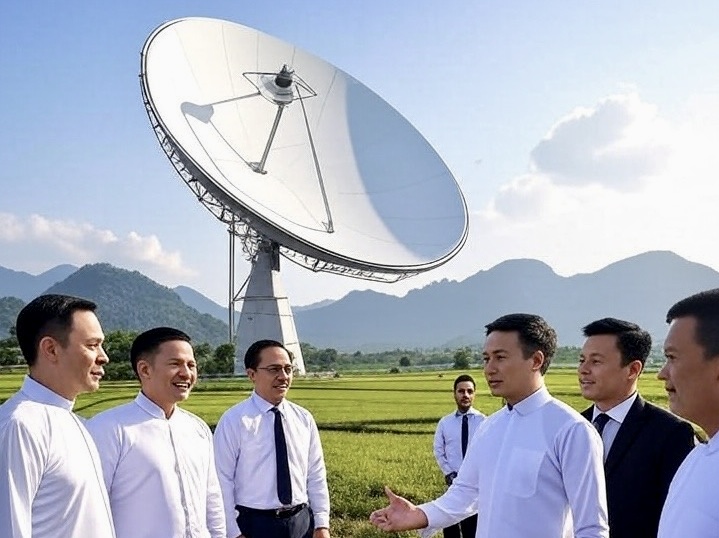
In a significant step toward bridging the digital divide, SpaceX’s Starlink satellite internet service is set to launch in Vietnam in the fourth quarter of 2025, marking a transformative moment for the country’s telecommunications landscape. This development, approved by the Vietnamese government under a five-year pilot program, is poised to enhance internet access in remote regions, bolster digital transformation, and reshape Vietnam’s connectivity infrastructure. With a potential investment of $1.5 billion from SpaceX, Starlink’s entry into Vietnam signals a blend of technological innovation and strategic diplomacy amid global trade dynamics.
A Game-Changer for Vietnam’s Internet Landscape
Vietnam, with a population of nearly 100 million, has made significant strides in internet adoption, with mobile broadband penetration reaching 90.26 per 100 people and fixed broadband at 22.98 per 100, according to the Ministry of Information and Communications in early 2024. However, challenges persist in rural and remote areas, where 5G towers and traditional fiber optic cables struggle to deliver reliable high-speed internet due to geographical barriers and weather conditions. Starlink’s low-earth orbit (LEO) satellite technology offers a solution by providing high-speed internet with minimal infrastructure, requiring only a compact user kit consisting of a dish, stand, and cables.
Unlike Vietnam’s existing satellites, Vinasat-1 and Vinasat-2, which primarily support television broadcasting and basic telecommunications with limited bandwidth, Starlink’s constellation of thousands of LEO satellites promises low-latency connectivity (20–40 ms) and global coverage. This makes it particularly suited for underserved areas such as mountainous regions, islands, and maritime zones, where it can empower communities with access to education, e-commerce, and digital economies. The service’s simplicity—users can self-install the kit with an automatic satellite-tracking function—further enhances its appeal for remote work and rural connectivity.
Regulatory Breakthrough and Strategic Context
The Vietnamese government’s decision to greenlight Starlink’s operations, announced on March 26, 2025, represents a significant policy shift. Previously, strict regulations limited foreign ownership of satellite internet providers, stalling SpaceX’s earlier attempts to enter the market in 2023. The new rules, passed by Vietnam’s National Assembly, allow Starlink to operate with full ownership of its local subsidiary under a pilot scheme running until January 1, 2031, with a cap of 600,000 subscribers. This change is seen as a diplomatic “olive branch” to SpaceX and the United States, particularly amid concerns over potential U.S. tariffs due to Vietnam’s $123 billion trade surplus with the U.S. in 2024.
The approval follows extensive negotiations, including high-level meetings between SpaceX representatives and Vietnamese officials. In September 2024, SpaceX’s Senior Vice President for Global Business, Tim Hughes, met with Vietnam’s Party General Secretary To Lam, outlining a $1.5 billion investment plan. Prime Minister Pham Minh Chinh further emphasized rapid licensing during a March 2025 meeting with U.S. businesses, signaling Vietnam’s intent to strengthen trade ties and avoid punitive tariffs under the Trump administration.
To support the rollout, SpaceX is establishing ground stations in Vietnam, with the first planned in Danang by May or June 2025 and up to 15 stations envisioned nationwide. These stations will optimize data transfers and allow Vietnamese authorities to monitor internet traffic, addressing national security concerns in a tightly controlled digital environment. The government has stipulated that Starlink comply with Vietnam’s cybersecurity laws, which mandate data sharing with authorities, aligning with requirements imposed on other tech giants like Google and Meta.
Opportunities and Challenges
Starlink’s entry into Vietnam offers significant opportunities. For rural communities, it promises to unlock access to global knowledge, e-commerce, and digital services, fostering economic growth and technological inclusion. The service’s ability to provide internet at sea and on airplanes also opens prospects for maritime industries and inflight Wi-Fi on Vietnamese airlines. Additionally, Starlink’s collaboration with local companies to distribute hardware and services could stimulate Vietnam’s tech ecosystem.
However, challenges remain. Starlink’s pricing—previously announced in 2021 as $599 for the installation kit and $99 monthly—may be a barrier in a market where local providers like Viettel offer household internet for as low as $6.55–$11.90 per month. While Starlink’s competitive edge lies in its reach and reliability, affordability will be critical to capturing a significant share of Vietnam’s 600,000-subscriber pilot cap. Moreover, compliance with Vietnam’s stringent cybersecurity regulations, including data localization requirements, may complicate operations, as Starlink will need to balance user privacy with government demands.
Critics, including Nguyen Quang A, former president of the Vietnam Association of Information Technology, have noted a dual-edged impact. While Starlink will enhance internet access and potentially enable freer expression online, the government’s ability to monitor traffic via local ground stations could strengthen state control over digital activities. This tension underscores the delicate balance between technological openness and regulatory oversight in Vietnam’s one-party system.
A Broader Regional Impact
Starlink’s launch in Vietnam is part of its broader Southeast Asian expansion, following successful rollouts in Indonesia, Malaysia, and Singapore. With services already available in over 130 countries, Starlink is positioning itself as a global leader in satellite internet, challenging traditional fiber and mobile tower networks. In Vietnam, the service’s potential to support disaster prevention, education, and digital economies aligns with the government’s goals for technological advancement, as outlined by Minister of Science and Technology Nguyen Manh Hung in April 2025.
The pilot program’s success could pave the way for long-term investment and regulatory reforms, potentially encouraging other foreign tech firms to enter Vietnam’s market. It also positions Vietnam as a strategic player in global tech and trade dynamics, leveraging Starlink’s capabilities to strengthen ties with the U.S. while advancing its digital infrastructure.
Looking Ahead
As SpaceX finalizes investment procedures and establishes a legal entity in Vietnam, the anticipated Q4 2025 launch of Starlink services marks a pivotal moment for the country’s digital transformation. By connecting remote regions, supporting economic growth, and navigating complex geopolitical currents, Starlink’s arrival could redefine Vietnam’s role in the global digital economy. However, its success will hinge on affordability, regulatory compliance, and the ability to deliver on its promise of seamless, high-speed connectivity.
For more information on Starlink’s plans in Vietnam, visit SpaceX’s official website or check updates from Vietnam’s Ministry of Science and Technology.






